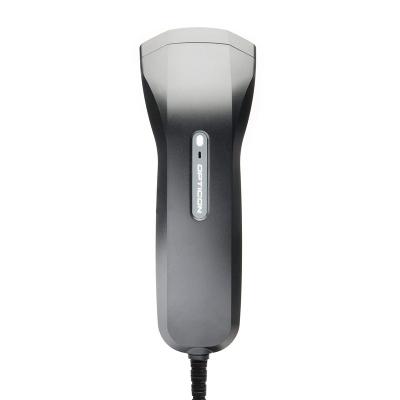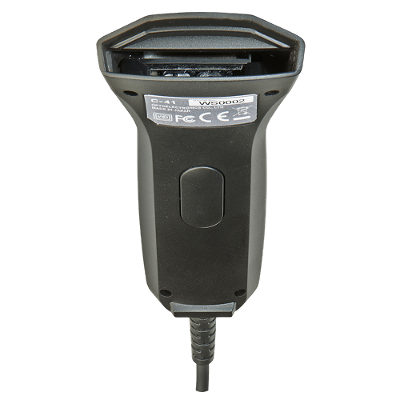C-41S
The C-41S is a durable 1D cabled CCD scanner with a wide optical window
About
The C-41S is a lightweight 1D scanner that operates at a speed of 300 scans per second
- Device will flash a BLUE LED and make a high pitched beep when it is connected to the computer.
- When the device reads a barcode correctly, it will flash a BLUE LED and make a high pitched beep to indicate a good read. If the device is unable to transmit the scanned data, it will emit a ringing sound to indicate the scanned data was not transferred correctly.
How To
Change Interface Modes and Restore Default Settings
- Interface Mode: Use this sheet to choose either USB-HID mode or USB-VCP mode.
Configure the Scanner
The output of this barcode reader can be modified in several different manners. Using several different tools. The following tools are available for you to use in configuring your scanner. Please submit a ticket above for assistance from Opticon's Technical Support Team.
Universal Menu Book
The Universal Menu Book (UMB) is a PDF document that enabled you to change the most commonly changed settings on Opticon's scanners. The UMB also contains information about what the various settings do when they are enabled. The UMB covers the following topics.
- Interface Specific Settings
- Code Opticons
- Barcode Symbology Settings
- Enabling/Disabling Symbologies
- String Options
- Prefixes / Suffixes
- Preambles / Postambles
- Read Options- Adjusting General Behaviors like:
- Disable Trigger (Always On)
- Single Read Mode / Multiple Read Mode
- Indicator Opticons
- Buzzer Settings
- LED Settings
Opticonfigure
Opticonfigure serves primarily as a an online searchable Universal Menu Book (UMB), however it does have some notable differences. Opticonfigure is updated more frequently than the UMB. Opticonfigure also contains some menu options that were excluded from the UMB for the sake of brevity. Although more inclusive, Opticonfigure doesn't do as good of presenting information in an organized and comprehensible manner as the UMB does. Opticonfigure allows you to: Create and print custom configuration sheets. Create custom configuration sheets and save them as PDF files. Create custom configurations and export OCG files. Create DataWizard configuration sheets.
DataWizard
Data Wizard allows you to modify barcode data before transmission. Currently it is able to add or remove characters, adjust the length of the output data, and remove entire sections of the barcode prior to transmission. Commonly each configuration will be designed to match different sizes, symbologies, or characters in barcode data. So for example if a user wants to truncate a Code-39 barcode of a specific length, but add characters to a Code 128 barcode, you wold make two configurations.
Interface Types
The C-41S supports USB-HID and USB-VCP interface types.
USB-HID Keyboard Emulation
This will be the most convenient interface for you to use as it doesn't require the use of special drivers or software. You can simply place your cursor where you want the barcode data to go, point, and scan.
To use this interface click on Interface Mode: and scan the USB-HID barcode to configure the C-41S in USB-HID keyboard mode.
USB-VCP Serial Port Emulation
If your software requires the use of a serial port to transmit and receive data, then you must choose this mode if you own a USB C-41S. First, download and install our USB Drivers, then click on Interface Mode: and scan the USB-VCP barcode to configure the C-41S in USB-VCP mode. After this, your PC will automatically detect that the C-41S is connected in Serial Port mode and will install the correct drivers.
Downloads
Documents
| Document | Description | Version | Download |
|---|---|---|---|
| DataSheet | Technical details at a glance. | Download | |
| Universal Menu Book | The Universal Menu Book is a document containing instructions and configuration options for the majority of Opticon's products. Support of the commands in this manual is product specific. A must read for System Integrators. In effect this is the User Manual for all of Opticon's products that do not have a User Manual of their own and a supplement to all others. | December 2009 | Download |

